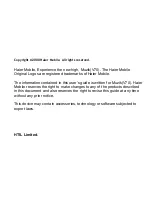
A generic, high-level functional block diagram of CU500 is shown in Figure 3-1. One antenna collects base station
forward link signals and radiates handset reverse link signals. The antenna connects with receive and transmit
paths through a switch module (plus two duplexers for UMTS high-band and low-band operations).
The UMTS receive signal is amplified by the RFL6202 LNA then passes through a bandpass filter before being
applied to the RFR6202 Receiver IC. On-chip circuits downconvert the received signal directly from RF to
baseband using radioOne Zero-IF techniques. Generation of the UMTS downconverter LO is distributed between
the RTR6250 (phase-locked loop), the RFR6202 (buffer amplifiers and LO distribution circuits) and external UHF
VCO and loop filter circuits. The RFR6202 IC outputs analog baseband signals for further processing by the MSM
device. This baseband interface is shared with the RTR6250 GSM850/GSM900/DCS/PCS receiver outputs.
GSM850, GSM-900, DCS and PCS receive signals pass through their bandpass filters then are applied to the
RTR6250 IC. Similar to the UMTS path, RTR6250 circuits downconvert the received signals directly from RF to
baseband. The GSM850/GSM900/DCS/PCS downconverter LO is generated mostly within the RTR6250 (PLL
and distribution functions); the UMTS Rx CH VCO and loop filter are off-chip. The RTR analog baseband outputs
are routed to the MSM6275 IC for further processing (an interface shared with the RFR).
The UMTS transmit path begins with analog baseband signals from the MSM device that drive the RTR6250 IC.
Integrated PLL and VCO circuits generate the Tx LO used in the quadrature upconverter that translates baseband
signals directly to RF. The RTR6250 output driver stages deliver fairly high-level signals that are filtered and
applied to the power amplifiers (PA). The PA output is routed to the antenna through a duplexer and switch
module.
The shared GSM-850, GSM900, DCS-1800, and PCS-1900 transmit path begins with the same baseband
interface from the MSM6275 IC that is used for the UMTS band. A single GSM850/GSM900/DCS/PCS quadrature
upconverter translates the GMSK or 8-PSK-modulated signal to a convenient intermediate frequency (IF) that
forms one input to an offset phase-locked loop (OPLL). OPLL functions are split between the RTR6250 IC and off-
chip loop filter and dual Tx VCO circuits, and translate the GMSK or 8-PSK-modulated signal to the desired GSM-
850, GSM-900, DCS-1800 or PCS-1900 channel frequency. This signal is applied to a dual power amplifier (only
one is active at a time). The enabled path continues with the PA, an automated power control (APC) circuit that
samples the transmit power and adjusts its level, the switch module (which includes a band-appropriate lowpass
filter), and the antenna.
CU500 power supply voltages are managed and regulated by the PM6650 Power Management IC. This versatile
device integrates all wireless handset power management, general housekeeping, and user interface support
functions into a single mixed signal IC. It monitors and controls the external power source and coordinates battery
recharging while maintaining the handset supply voltages using low dropout, programmable regulators.
The device’s general housekeeping functions include an ADC and analog multiplexer circuit for monitoring on-chip
voltage sources, charging status, and current flow, as well as user-defined off-chip variables such as temperature,
RF output power, and battery ID. Various oscillator, clock, and counter circuits support IC and higher-level
handset functions. Key parameters such as under-voltage lockout and crystal oscillator signal presence are
monitored to protect against detrimental conditions.
3. TECHNICAL BRIEF
- 18 -
Summary of Contents for CU500 - Cell Phone
Page 1: ...Date June 2006 Issue 1 0 Service Manual Model CU500_TU500 Service Manual CU500_TU500 ...
Page 3: ... 4 ...
Page 41: ...3 TECHNICAL BRIEF 42 Figure PM6650 Functional Block Diagram ...
Page 68: ...4 TROUBLE SHOOTING 69 4 1 RF Component Bottom Side 4 TROUBLE SHOOTING ...
Page 69: ...4 TROUBLE SHOOTING 70 ...
Page 73: ...4 TROUBLE SHOOTING 74 Check R400 of PMIC U400 Check R223 of MSM U200 ...
Page 77: ...4 TROUBLE SHOOTING 78 For testing Max power of UMTS 1900MHz is needed ...
Page 85: ...4 TROUBLE SHOOTING 86 ...
Page 87: ...4 TROUBLE SHOOTING 88 ...
Page 91: ...4 TROUBLE SHOOTING 92 ...
Page 95: ...4 TROUBLE SHOOTING 96 R300 Q401 Q400 ...
Page 98: ...4 TROUBLE SHOOTING 99 Q501 X 200 U505 ...
Page 105: ...4 TROUBLE SHOOTING 106 CN602 CN1 ...
Page 107: ...4 TROUBLE SHOOTING 108 C102 C104 R200 R201 ...
Page 109: ...4 TROUBLE SHOOTING 110 CN602 SPK_LP L N SPK_RP RN AMP block ...
Page 111: ...4 TROUBLE SHOOTING 112 MIC U303 ...
Page 113: ...4 TROUBLE SHOOTING 114 Mic input 5 4 2 1 3 6 Headset detect port ...
Page 129: ...5 DOWNLOAD 130 3 NV Restore error When you meet the NV Restore error ...
Page 130: ...5 DOWNLOAD 131 Connect to the phone Click on Cancel ...
Page 135: ...Table 6 1 1 RF Block Component 6 BLOCK DIAGRAM 136 ...
Page 138: ...6 BLOCK DIAGRAM 139 Top Side ...
Page 139: ...6 BLOCK DIAGRAM 140 Bottom Side ...
Page 147: ... 148 8 pcb layout ...
Page 148: ... 149 8 pcb layout ...
Page 149: ... 150 8 pcb layout ...
Page 150: ... 151 8 pcb layout ...
Page 151: ... 152 ...
Page 157: ...9 CALIBRATION 158 9 3 HOT KIMCHI Example Choose Exe_Cu500Ag_100 ...
Page 158: ...9 CALIBRATION 159 Click APPLY button Click START button ...
Page 161: ... 162 ...
Page 185: ...Note ...
Page 186: ...Note ...
















































